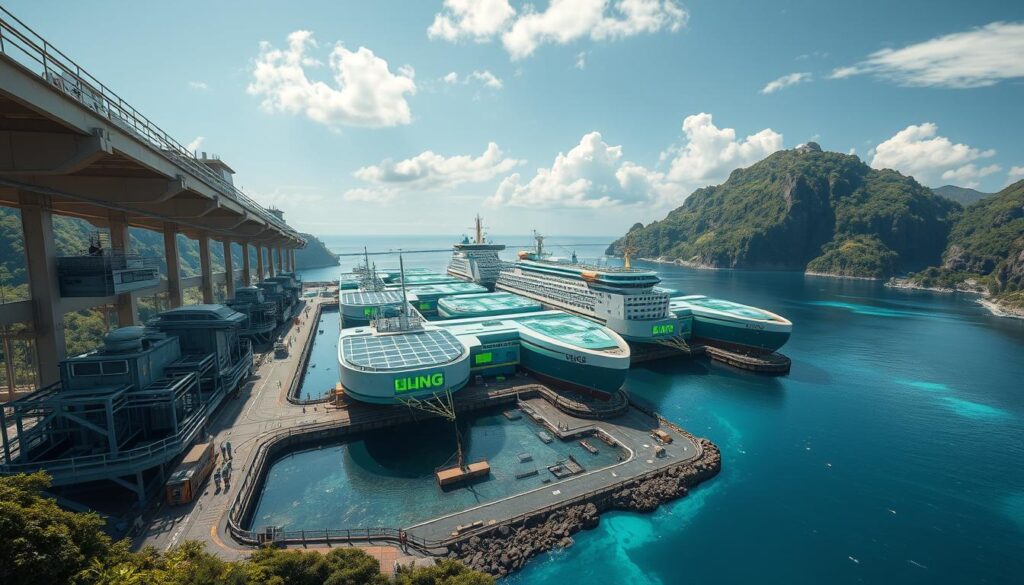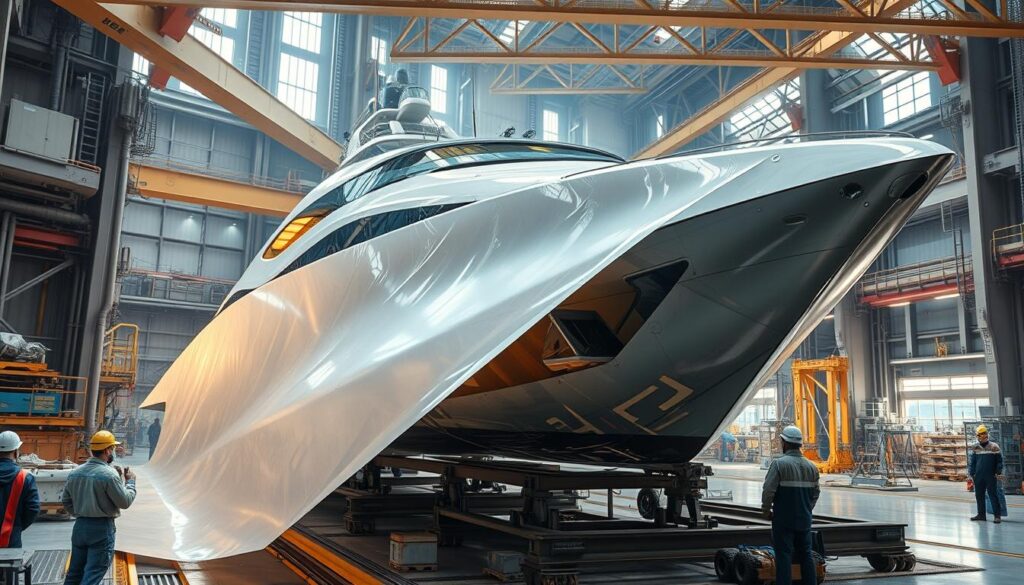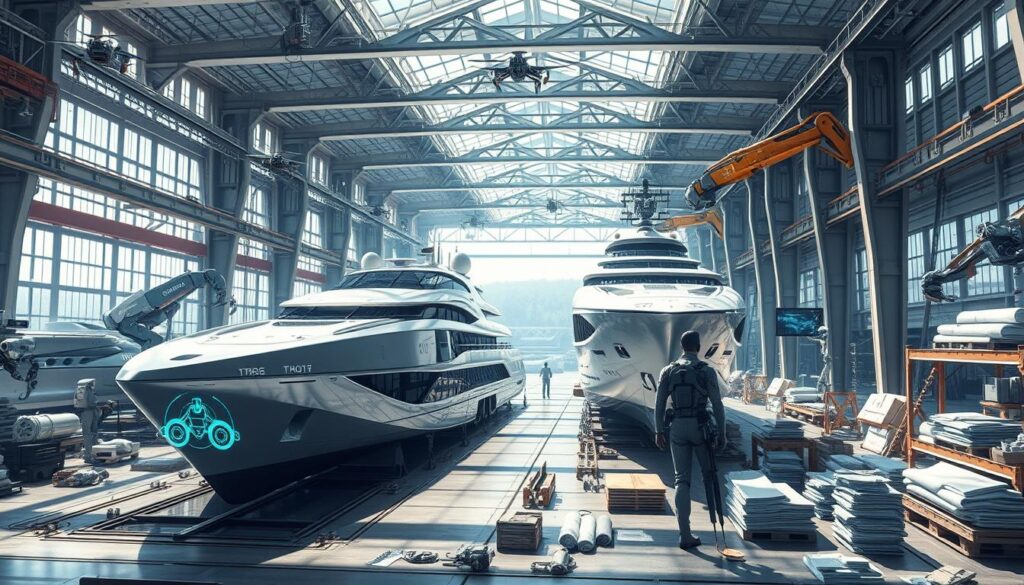-
 Jetzt anrufen! +86-13912367818
Jetzt anrufen! +86-13912367818 -
 Jetzt mailen info@wxhlhg.com
Jetzt mailen info@wxhlhg.com


Explore how cutting-edge shipbuilding technology revolutionizes the maritime industry, enhancing efficiency and design in modern vessel construction.
Shipbuilding technology and modern advances are creating a new era. This era brings great efficiency and cares for the environment in the maritime industry. The use of 3D printing now makes it easier and cheaper to turn drawings into real ship parts1.
Robots are taking over hard physical jobs. This makes work safer and reduces the need for people1.
LNG-fueled technologies are helping reduce CO2 and other pollutants1. The move towards naval innovation includes using wind and solar energies. This shows a commitment to less fuel use and lower emissions1.
Materials like buckypaper are making ships safer and more durable1.
Leaders in the industry are embracing digital transformation. They use new designs and electric propulsion for less impact on nature1. These smart, sensor-based systems improve efficiency and cut costs. They also focus on reducing emissions for a cleaner future2.

● Advances in 3D printing are refining manufacturing processes for the maritime industry1.
● Robotics in shipbuilding promises heightened safety and a curtailing of skilled labor needs1.
● LNG-fueled engines are a beacon for emission reduction in ship travel1.
● Exploring renewable energy sources in shipping underscores a commitment to sustainability.
● The development of buckypaper could revolutionize material use in shipbuilding.
● Electric propulsion integration signifies a leap forward in operational efficiency.
● Real-time data from smart ship solutions offer unparalleled process optimization.
3D printing is changing shipbuilding in a big way. It shifts how marine technology evolves. By turning complex CAD models into real parts, ships are designed more precisely and efficiently.
3D printing breaks old limits, making way for complex designs.
This approach improves manufacturing and sparks innovation in ship design.
Printing parts as needed cuts down storage and logistic problems. A Lloyd's Register study shows that 3D printing could reduce lead times by up to 40% and cut inventory costs by half for the maritime industry.
This makes for leaner storage and faster part customization, avoiding traditional supply chain delays.
Adopting 3D printing in marine tech isn't without its issues. It faces material and part integration challenges. Yet, innovations are being made. For example, MPA and DNV have developed 3D printing guidelines to ensure part quality and safety3.
The 3D printing scene in shipbuilding is growing fast. Expected to reach $1.8 billion by 2026, its use will keep transforming ship design and manufacturing.
As 3D printing matures, it's set to overhaul shipbuilding. Advances are overcoming early hurdles. This means big changes in how ships are made and kept up.
We aim to improve safety and efficiency in shipyards through robotics and advanced sensors. This change made building ships faster and more precise. By using robots, shipyards change how they work in big ways.
Robotics have changed how shipyards handle tasks, both big and small45. They use robots for lifting and moving things safely and quickly. Now, jobs like welding and painting are done by robots with amazing accuracy45.
This not only makes building ships faster but also keeps things very safe and high-quality6.
Sensors are key in making shipbuilding robots work well. They let robots do complex jobs with great accuracy. Robots and drones with sensors and cameras gather important information. This helps in checking quality and safety in hard-to-reach spots6.
Thanks to sensors, robots are now more capable, and shipyards work more precisely and effizient.
Shipyards are now using smaller, smarter robots. These robots work well in tight and dangerous spaces, making things safer and better4. They do risky jobs safely, protecting workers and improving shipbuilding.
Using robots in shipyards means fewer work accidents and tackles worker shortages4. As technology gets better, including AI, shipbuilding is becoming more advanced. This means higher quality, safety, and efficiency.
| Merkmal | Benefits | Statistical Data |
| Automated Welding and Painting | Increases precision, reduces waste | Efficiency up by 25%4 |
| Material Handling Robots | Operates 24/7, reducing assembly time | Labor costs reduced by 30% over time5 |
| High-Resolution Inspection Drones | Improve quality control and speed up inspections | Accident rates reduced by 15%6 |
The move to ballast-free ship design is a big step in marine engineering. It also shows that we care about ecological innovation. This method cuts the environmental dangers linked with managing ballast water. Normally, ships that carry 80 percent of the world's goods use lots of ballast water. This water can bring harmful marine species into new places every day.
To deal with these issues, the International Maritime Organization (IMO) set new rules. They aim to lessen the harm from ship ballast water8. However, adding these systems to old ships is costly and hard. The ballast-free idea is a smart answer. For example, the Triality VLCC and some container ships don't need ballast water. DNV GL and the Shipbuilding Research Centre of Japan made these innovative and sustainable designs9.
| Concept | Developer | Features |
| Triality VLCC | DNV GL | Ballast-free, energy efficient, lower emissions |
| Orcelle | Wallenius Wilhelmsen Logistics | No ballast water required; runs on renewable energy sources |
| Aubalex system | Vela International Marine | Expels ballast water species within 500 miles of uptake9 |
However, there are still hurdles in making ballast-free ships common. The starting costs and the need for new setups are big. Industry players and rule-makers must both commit. Plus, we need to deal with higher costs for building and running these ships. This comes from their design, as recent projects have shown8.
Still, we can't wait to use these green technologies. Our seas need them. By working together and pushing marine engineering forward, we can lessen shipping harm to nature. It's time for the shipping world to fully adopt ballast-free design. It should become the norm for keeping our seas safe79.
The maritime industry is moving towards sustainable marine technology. LNG-fueled ships are key for energy efficiency. They meet strict environmental rules and cut operational costs. These ships mainly use methane in LNG, making emissions much lower than traditional fuels. They emit mostly water vapor and little carbon dioxide10.
LNG engines can cut CO2 emissions by 30 to 50% compared to old marine fuels10. This big drop is joined by a huge cut in sulfur oxides and particles, nearly 95%. This makes the air cleaner and puts less harm on sea life11.
But changing to LNG is tough. It needs bigger fuel tanks and special stuff, adding costs and complex stuff10. Still, the pluses in money saving and environment push the market. The LNG ship count might hit 1,000 by 2030, up from just 18 in 201011.
The world LNG market is also set to get bigger. Trade could go up by 21% by 202511. So, adding LNG to our ships is a big step toward a cleaner and better global freight system.
| Benefit | Statistic | Auswirkungen |
| CO2 Emissions Reduction | 30-50%10 | Enhances air quality and complies with global regulations |
| Sulfur Oxides and Particulates Reduction | Up to 95%11 | Reduces ocean and air pollution |
| Cost of LNG Implementation | Initial high cost but long-term savings10 | Cost-efficient in the long run despite high upfront investment |
| LNG Market Growth by 2025 | 21% increase11 | Indicates robust industry adoption and expansion |
Pushing for LNG-fueled ships shows their key role in sustainable marine technology. Their mix of money and green pluses makes LNG a main player. This is important for the future of our oceans and shipping practices.

To meet the need for green shipping, we're embracing solar and wind power. These green sources help cut pollution and costs while improving energy security on ships.
Using solar and wind energy for ship movement is revolutionary. The U.S. plans to boost offshore wind to power millions of homes and create many jobs12. The Aquarius system, merging sails with solar panels, aims to make ships more sustainable13.
Fitting big renewable systems on ships is tough. However, the EnergySail design can adjust to different ships, like cruise ships13. This flexibility helps us use solar and wind power on various ships effectively.
| Rigging Type | Benefits | Specific Applications |
| Solar Panels | Augments propulsion, decreases fuel consumption | Powering onboard systems and reducing operational costs |
| Rigid Sails | Combines the benefits of wind and solar energy, enhancing overall efficiency | Significantly beneficial for large vessels such as cargo ships and tankers |
| Integrated Systems (e.g., EMP's EnergySail) | Experimental applications on various ship types, including retrofits and new constructions13 | Combines the benefits of wind and solar energy, enhances overall efficiency |
We're focused on developing and fitting these green technologies on ships. Our goal is to start a new, sustainable era in shipping.
Buckypaper is changing how we build ships. It's light but very strong. This helps ships to be better and kinder to the planet.
Buckypaper is super strong but doesn't weigh much. It comes from carbon nanotubes. Ships built with it are lighter, use less fuel, and perform better.
Buckypaper is great at stopping fires and fighting rust. These features make ships safer and last longer. They stay strong even in the tough sea conditions.
Using buckypaper worldwide will set new highs in shipbuilding. It shows our pledge to innovation in the marine world.
| Region | Market Share in 2017 | Position in Global Shipbuilding |
| China | 44.8% | 1st |
| Korea | 24.7% | 2nd |
| Japan | 23.8% | 3rd |
| Europe | 4.6% | 4th |
| Rest of World (RoW) | 1% | 5th |
In 2017, China was the top shipbuilder with 44.8% market share14. Korea was next with 24.7%14. This shows Asian countries are leading in shipbuilding14.
Shipbuilding technology is changing fast. We now focus more on being environmentally friendly. We're working on things like integrated electric propulsion, maritime cybersecurity, and becoming more digital.
Using integrated electric propulsion makes ships work better and pollute less. Startups are creating emission-free ways to power ships. For example, Amogy is working on Carbon-Free Ammonia Fuel15. This is a big step towards ships that don’t harm the ocean.
Ships use more digital systems now, so we must protect them from cyber attacks. Alphaabets Digital Labs is working on technology that helps monitor ships better15. Also, Dassault Systems’ 3DEXPERIENCE helps keep ship data safe from hackers16. Working together, these efforts make ships more secure.
Digital platforms help shipbuilders work together better and faster. Groupe Beneteau uses TechViz 3D tools for this16. These tools let engineers from all over the world work together in real time. This makes building ships faster and better.
Shipbuilding technology is leading the way in making changes. With new propulsion systems, cybersecurity, and digital tools, we're making ships smarter and safer. This makes the future of sailing very exciting.

In shipbuilding, merging technological advancements, naval architecture, and marine engineering signals a new era. This blend includes 3D printing, advanced robotics, and buckypaper. Such innovations strengthen sustainable shipbuilding. They greatly improve maritime vessels' performance and safety. The MARITECH program, with its $40 million yearly budget, supports this progress. It aims to shift U.S. ship sales by making 30 to 50 large commercial ships a year17. This effort showcases the brilliance of U.S. shipbuilders. They create sophisticated vessels that surpass standard commercial needs17.
U.S. shipbuilders are highly skilled. Yet, selling their high-tech ships globally remains challenging. High costs often deter buyers, as found in the Anderson and Sverdrup analysis18. But research from MARAD and others, like Dallas and McGrady, gives hope. It guides us on improving U.S. competitiveness in global shipbuilding18. These reports help us balance tech innovation with cost.
Mekalite stays true to the Craftsman spirit. We focus on precision and quality in the maritime field. The SCF reports look at how shipbuilding aid shapes our strategy. It aligns us with leading OECD subsidizing countries. This plan aims to place us strongly in a competitive global market1718. Mekalite aims to provide top manufacturing solutions. We prioritize client satisfaction through skill and reliability. As we face digital change, we continue the legacy of craftsmanship. We move towards a future where maritime excellence and sustainability go hand in hand.
Modern technology changes how we build ships. It brings digital advances and new designs that improve how we construct vessels. These technologies make building ships faster, safer, and more eco-friendly. 3D printing, robots, and digital tools are key in making the industry better.
3D printing turns designs into real ship parts. It improves shipbuilding and makes the design process smoother. This method allows for precise and complex parts to be made easily. It also cuts down on the need for keeping a lot of spare parts, thanks to on-the-spot printing.
Robots are very important in making shipyards safer and more efficient. They handle heavy lifting and detailed welding tasks. These robots are equipped with advanced sensors for AI-driven tasks. They are moving toward smaller, smarter designs for tough and hard-to-reach areas.
Ballast-free ship design is a green breakthrough in ship engineering. It gets rid of the need for ballast water, which can harm marine life. This design uses a system of pipes for constant water flow. It makes ships safer for the environment and work better.
LNG-fueled ships use cleaner energy, which means they pollute less. They emit fewer greenhouse gases and less air pollution than traditional fuels. This makes operating costs lower. They are a big step towards an eco-friendly shipping world.
Adding renewable energy like solar and wind to ships is tough because of limited space. But, it presents chances to cut down on fuel use and emissions. This movement helps make shipping more sustainable.
Buckypaper is made from carbon nanotubes. It's very strong yet light, making it great for building ships. It helps in fire protection and fights corrosion. This leads to safer and more fuel-efficient ships.
New electric propulsion systems are making ships run cleaner and more efficiently. Cybersecurity is also becoming very important as ships use more digital tools. These advances are improving how ships perform and use fuel, keeping them safe, too.
Schreibe einen Kommentar